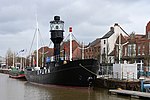Earl de Grey, Kingston upon Hull

The Earl de Grey is a pub (public house), constructed in the early 19th century in the centre of Kingston upon Hull, England. The building is three storeys high, it had a slate roof and has a green and cream-coloured fascia (tiling) covering the front of the ground floor, which was added around 1913, decorated with Ionoic pilasters. The first records of the pub appear in 1931 when it was originally named Junction Dock Tavern; it was renamed in the 1860s after the Earl de Grey at the time, George Robinson, 1st Marquess of Ripon. The Earl de Grey was popular with seafarers, being located close to the docks and in what was at the time Hull's red-light district. The faience ground floor was likely added around 1913, when the interior was renovated by the then owner, Bentley's Yorkshire Brewery. The exterior of the building was given grade II listed status for its historic value in 1994. Since then it has had extended periods of closure and disuse. According to a local legend: in the 1980s the pub was home to two parrots Cha Cha and Ringo. A burglar broke in and fearing that the parrots would alert the pub's landlord, stabbed Cha Cha to death. Following the ordeal Ringo then never spoke again. The two parrots are thought to be buried nearby. In 2018, property developer Wykeland announced that the Earl de Grey would be moved to make room for redevelopment of Castle Street. The Earl de Grey's new location is about 100 feet (30 m) from where it stood originally. The front of the building was disassembled and placed into storage in 2020. Reconstruction work began in January 2024 and is due to be completed in 2025, forming part of a restored Castle Street Chambers.
Excerpt from the Wikipedia article Earl de Grey, Kingston upon Hull (License: CC BY-SA 3.0, Authors, Images).Earl de Grey, Kingston upon Hull
Waterhouse Lane, Hull Old Town
Geographical coordinates (GPS) Address Nearby Places Show on map
Geographical coordinates (GPS)
| Latitude | Longitude |
|---|---|
| N 53.741209 ° | E -0.341095 ° |
Address
Waterhouse Lane
HU1 3RD Hull, Old Town
England, United Kingdom
Open on Google Maps










